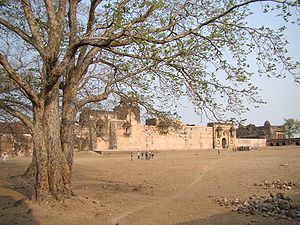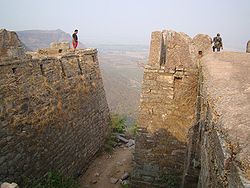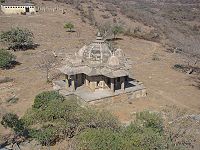
Rohtasgarh Fort
Encyclopedia

Bihar
Bihar is a state in eastern India. It is the 12th largest state in terms of geographical size at and 3rd largest by population. Almost 58% of Biharis are below the age of 25, which is the highest proportion in India....
. The culture of the Sone Valley is best symbolized by the Rohtas Fort which is a testimony of strength and power. Sadly, the majestic fort lies in utter state of ruins reminiscent of its great past, frequented few times by the naxalites and the police patrol parties. Proximity to the naxalite affected areas has rendered the fort quiet inaccessible in recent times.
Origins

Harishchandra
Harishchandra, in Hindu religious texts is the 36th king of the Solar Dynasty, Surya Maharishi Gothram . His legend is very popular and often told as a benchmark for an ideal life. He was renowned for his piety and justice. His name is Sanskrit for "having golden splendour".Harishchandra had two...
of the Solar dynasty and was named after his son Rohitasva after whom the fort (Rohtasgarh) was named. The Rohtas Fort was constructed on a plateau over the top of a hill with steeply rising sides. The steps directing to the fort cut into limestone of the hill. Many streams crossed the plateau and the soil was productive, which help in easy growth of the crops, so that the inhabitants of the fort could hold out for months against an enemy besieging the fort. Forest and wild animals surrounded the hill and dacoits provided other natural and man-made barriers. Thus the fort could not be taken by force but only by deceit and cunningness.
Location
Rohtasgarh is situated on the upper course of the river Son, 24° 57′ N, 84° 2′E. It takes around two hours from SasaramSasaram
Sasaram , sometimes also spelled as Sahasram, is the administrative headquarters of the Rohtas district in the Indian state of Bihar.It is one of the oldest cities in India, and is famous for production of stone chips and for the local quarrying industry...
to reach the foot of the hill over which is the Rohtas fort.It can be reached easily from (Dehri on sone) town. Dehri on sone town has very good road network through which one can easily reach Rohtasfort. The fort is situated at about 1500 feet above sea level. The 2000 odd limestone steps were probably meant for elephants. For the visitor they are exhausting climb of an hour and a half. At the end of the climb, one reaches the boundary wall of the fort. A dilapidated gate with a cupola can be seen there, which is the first of many gates provided for well-guarded entrances to the fort. From here one has to walk another mile or so before the ruins of Rohtas can be seen.
History
The history of Rohtas is a long and chequered one. The old texts and inscriptions found near Rohtas suggest that the fort was in the possession of the Hindu king Pratapdhavala of the Japla dynasty. Other inscriptions cite that it was ruled by the Khayarwala clan who were sovereigns of Shahabad (the area now includes Bhojpur, Buxar, Kaimur and Rohtas). The Hindu kings of Rohtas constructed a road through the jungle leading from the foothill to the plateau, did the fortifications on the jungle roads and the four gates on the four ghats. The main fortifications at the Raja Ghat and the Katauthiya Ghat can still be seen. Except from the matrix for making seals belonging to the 7th century AD king Sasanka, all other artifacts are from the time of Sher Shah Suri and onwards.In 1539 AD, the Fort of Rohtas passed out of the hands of the Hindu kings into those of Sher Shah Suri
Sher Shah Suri
Sher Shah Suri , birth name Farid Khan, also known as Sher Khan , was the founder of the short-lived Sur Empire in northern India, with its capital at Delhi, before its demise in the hands of the resurgent Mughal Empire...
. Sher Shah Suri had just lost the Fort at Chunar
Chunar
Chunar छुनर شُنَر, located in Mirzapur District of Uttar Pradesh state, India, is an ancient town. The railway tracks passing through Chunar leads to major destinations of India, including Howrah, Delhi, Tatanagar and Varanasi. National Highway number 7 also passes through Chunar...
in a fight with the Mughal emperor Humayun
Humayun
Nasir ud-din Muhammad Humayun was the second Mughal Emperor who ruled present day Afghanistan, Pakistan, and parts of northern India from 1530–1540 and again from 1555–1556. Like his father, Babur, he lost his kingdom early, but with Persian aid, he eventually regained an even larger one...
and was desperate to gain a foothold for himself. Sher Shah requested the ruler of Rohtas that he wanted to leave his women, children and treasure in the safety of the fort, while he was away fighting in Bengal. The king agreed and the first few palanquins had women and children. But the later ones contained fierce Afghan soldiers, who captured Rohtas and forced the Hindu king to flee. During the Sher Shah's reign 10000-armed men guarded the fort.
Haibat Khan, a trustworthy soldier of Sher Shah built the Jami Masjid in 1543 AD, which lies to the west of the fort. It is made of white sandstone and comprises three domes. There is a mausoleum of perhaps Habsh Khan, the daroga or the superintendent of works of Sher Shah.
In 1558 AD, Raja Man Singh, Akbar's Hindu General, ruled Rohtas. As the Governor of Bengal and Bihar, he made Rohtas his headquarters in view of its inaccessibility and other natural defenses. He built a splendid palace for himself, renovated the rest of the fort, cleared up the ponds and made gardens in Persian style. The palace was constructed in a north-south axis, with its entrance to the west with barracks for soldiers in front. The fort is still in a fairly good condition.
After the death of Man Singh, the fort came under the jurisdiction of the office of the Emperor's wazir from where the governors were appointed. In 1621 AD, the Prince Khurram revolted against his father Jahangir and took refuge at Rohtas. The guardian of the fort, Saiyyad Mubarak handed over the keys of Rohtas to the prince. Khurram once again came to Rohtas for safety when he tried to win Avadh, but lost the battle of Kampat. His son Murad Baksh was born to his wife Mumtaz Mahal. During Aurangzeb's reign the fort was used as a detention camp for those under trial and housing prisoners sentenced for life.
In 1763 AD, in the Battle of Udhwa Nala, the Nawab of Bihar and Bengal, Mir Kasim, lost to the British and fled with his family to Rohtas. But he was not able to hide at the fort. Finally the Diwan of Rohtas, Shahmal handed it over to the British Captain Goddard. During his two-month stay at the fort, the Captain destroyed the storeroom and many of the fortifications. Goddard left, keeping some guards in charge of the fort, but they too left after a year.
There was peace at the fort for the next 100 years or so, which was at last broken at the time of the First War of Independence in 1857. Amar Singh, the brother of Kunwar Singh, together with his companions took refuge here. There were many encounters with the British where the latter were at a disadvantage, for the jungles and the tribal in them were of great help to the Indian soldiers. Finally, after a long drawn out military blockade and many clashes, the British overcame the Indians.
Hathiya Pol and Elephant Gate

The Aina Mahal
The Aina Mahal, the palace of the chief wife of Man Singh, is in the middle of the palace. The most expansive structure within the palace is however the Takhte Badshahi, where Man Singh himself resided. It is a four-storied building, with a cupola on top. There is an assembly hall in the second floor and a gallery resting on strong, engraved stone pillars. The third floor has a tiny cupola, which opens into the women' quarters. From the fourth floor one can get a bird's eye view of the surrounding area. The residential quarters of Man Singh were on the first floor, which was connected to the ladies' rooms via a gateway in the east. An assembly hall, probably the Diwan-i-Khas or the hall or private audience is a little towards the west of Baradari or the hall of public audience. The hall is decorated with etchings of flowers and leaves, and lies on similarly decorated pillars.Jami Masjid and Habsh Khan's mausoleum
Outside the palace grounds are the buildings of Jami Masjid, Habsh Khan's Mausoleum and the Makbara of Shufi Sultan. The beautiful stucco style, with the cupola resting on pillars reminds of the Rajputana style where the domed structures are known as chhatris. This style had not been used in Bengal and Bihar earlier but its emergence at Rohtas was not surprising as more than half the fort's guardians came from Rajputana.Ganesh Temple

The Hanging House

Rohtasan Temple And Devi Temple


